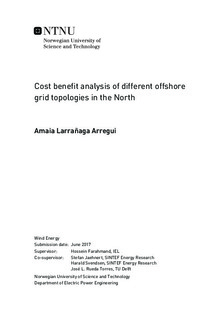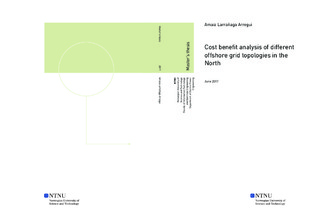| dc.description.abstract | European countries are showing their willingness to reduce their greenhouse gases emissions in the coming years. For example, the Paris agreement within the United Nations Framework Convention on Climate Change (UNFCCC) is one of the most crucial steps that countries have signed recently. The aim is to cause a lower global temperature increase, and thus, to reduce the resulting climate risks.
North Sea countries are working on a greener future in a national level, as well; and these are in fact, the countries which are the most concerned about the climate change globally. Moreover, these are affluent in terms of opportunities for using greener energy sources, due to their climatic and geographic conditions. Clear examples are hydropower plants in the Nordic region or offshore-wind in the North Sea.
Nevertheless, these countries need also of infrastructure to achieve their objectives, such as a Power System which will enable to integrate green generation sources properly and to satisfy the societies energy needs successfully. Power Systems are in fact, needed key enablers of this energy transition.
The topic of this Master Thesis is transmission expansion planning in the North Sea for the year 2030. PowerGIM and PowerGAMA are used. The objective is to find the socio-economically beneficial grid design which will help achieve these future ambitions that the North Sea countries have and at the same time, which will be robust w.r.t. renewable energy sources development uncertainty. The main finding of this Master Thesis is that Dogger Bank hub is obtained as part of the most socio-economically beneficial offshore-grid layout for the year 2030, in all implemented scenarios. Each scenario refers to one implemented ENTSO-E Vision (Visions 1-4) with some additional assumptions.
In short, in this Master Thesis, four different offshore-grid layouts are obtained, one per each implemented scenario; and all of them have the same core. The core is Dogger Bank hub s interconnection with Great Britain, Belgium, Germany, Netherlands, Norway and Denmark. Nevertheless, there are some variations which depend on the implemented scenario and on the implemented assumptions. Overall, the obtained Dogger Bank hub could also integrate between 13-32 GW offshore-wind in the North Sea.
Then, a reference grid layout is created, as well. This design embraces the previously mentioned four grid layouts in a conservative way, i.e. the repeated lines in all four obtained grid layouts are taken with the lowest capacity value among all four designs.
The grid layout obtained after the implementation of the second scenario is the most robust grid layout w.r.t. different future energy prospects. Its operational cost saving throughout the lifetime of 30 years w.r.t. the reference grid layout is of 20-33 bn , depending on the implemented future scenario; and the investment cost increase is of 5.5 bn w.r.t. the reference grid layout.
Index terms: Power System Planning, Power Transmission, Power System Management, Power System Economics, Power System Modelling, Load Flow. | |

